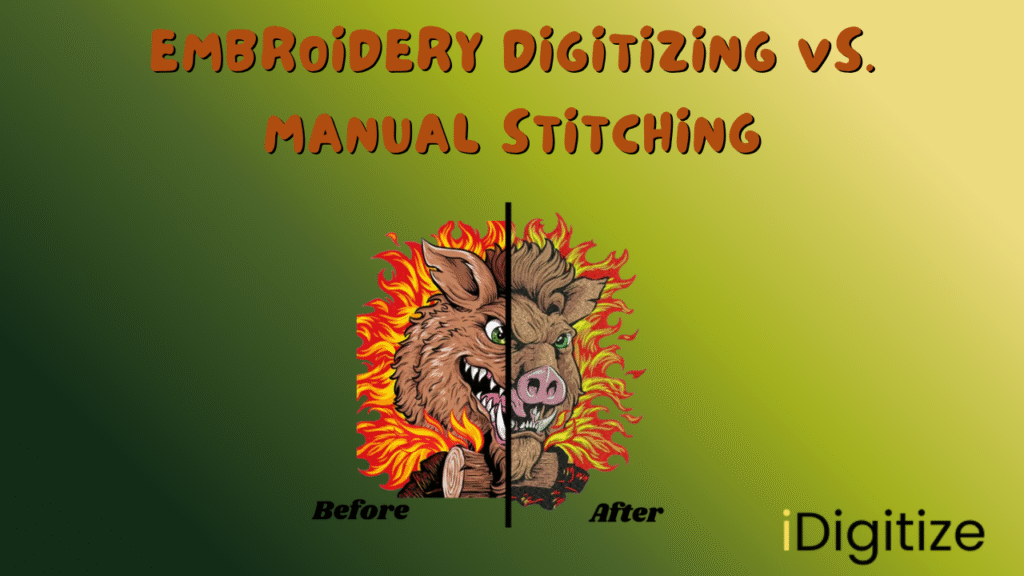Embroidery is a timeless art form, cherished for its ability to transform fabrics into stunning, personalized creations. However, the methods used to create embroidered designs have evolved significantly, with embroidery digitizing and manual stitching representing two distinct approaches. At iDigitize, we specialize in delivering high-quality digitizing services that empower businesses and individuals to achieve professional results. This blog compares embroidery digitizing and manual stitching, exploring their processes, benefits, limitations, and ideal use cases to help you decide which method suits your needs.
What Is Embroidery Digitizing?
Embroidery digitizing is the process of converting a digital image, such as a logo or artwork, into a machine-readable file that instructs an embroidery machine on how to stitch the design onto fabric. This file includes precise details about stitch types, directions, density, and sequence, ensuring consistent and accurate results. Using specialized software, iDigitize creates files in formats like DST, PES, or JEF, tailored to your embroidery machine, enabling automated, high-quality production.
What Is Manual Stitching?
Manual stitching, often referred to as hand embroidery, involves creating designs by hand using a needle, thread, and fabric. This traditional method relies on the skill and creativity of the embroiderer, who manually stitches patterns, logos, or artwork onto the material. Manual stitching is an artisanal craft, valued for its unique, handcrafted aesthetic and the personal touch it brings to each piece.
Key Differences in Process
The processes for embroidery digitizing and manual stitching differ significantly in their approach and execution:
-
Digitizing Process: At iDigitize, we start with a digital design, import it into advanced software, and map out stitch paths, types, and colors. The design is adjusted for fabric type and machine compatibility, followed by a test stitch-out to ensure quality. The resulting file is loaded into an embroidery machine for automated production.
-
Manual Stitching Process: Hand embroidery begins with sketching or transferring a design onto fabric. The embroiderer selects threads and stitch techniques (e.g., satin, cross-stitch, or chain stitch) and manually stitches the design, often over hours or days, depending on complexity.
Digitizing is technology-driven and automated, while manual stitching is labor-intensive and relies on human skill.
Benefits of Embroidery Digitizing
Embroidery digitizing offers several advantages, making it a preferred choice for many businesses and individuals:
-
Speed and Efficiency: Digitized designs are stitched quickly by machines, ideal for large orders or tight deadlines. iDigitize delivers files that streamline production, saving you time.
-
Consistency: Automated machines ensure every piece is identical, crucial for branding or uniform production. iDigitize optimizes files for flawless replication.
-
Complex Designs: Digitizing handles intricate, multi-colored designs with ease, which would be challenging to achieve manually.
-
Scalability: Once digitized, a design can be reused indefinitely, making it cost-effective for bulk production.
-
Versatility: iDigitize creates files suitable for various fabrics, from delicate silks to sturdy denim, expanding creative possibilities.
Benefits of Manual Stitching
Manual stitching has its own unique strengths, particularly for those seeking a traditional or bespoke approach:
-
Artisanal Quality: Hand embroidery offers a one-of-a-kind, handcrafted look that conveys authenticity and charm.
-
Creative Flexibility: Embroiderers can adapt designs on the fly, experimenting with textures and techniques that machines may not replicate.
-
Cultural Significance: Manual stitching is often rooted in cultural or historical traditions, making it ideal for heritage-inspired projects.
-
Low Initial Cost: No specialized software or machines are needed, just needles, thread, and fabric, making it accessible for hobbyists.
Limitations of Embroidery Digitizing
While powerful, digitizing has some limitations:
-
Initial Investment: Digitizing requires software, skilled professionals, and embroidery machines, which can be costly upfront. iDigitize mitigates this with affordable services.
-
Learning Curve: Creating high-quality digitized files requires expertise, though iDigitize handles this for you.
-
Design Constraints: Very fine details or certain textures may need simplification to work with machine embroidery.
Limitations of Manual Stitching
Manual stitching also comes with challenges:
-
Time-Consuming: Even simple designs can take hours or days, making it impractical for large orders or tight schedules.
-
Inconsistency: Human error can lead to variations in stitch quality or design placement, unsuitable for uniform branding.
-
Physical Demand: Hand embroidery is labor-intensive, requiring steady hands and patience, which may limit output.
-
Limited Complexity: Intricate or multi-colored designs are difficult and time-consuming to execute manually.
When to Choose Embroidery Digitizing
Embroidery digitizing is ideal for scenarios requiring speed, consistency, and scalability:
-
Business Branding: Companies needing logos on uniforms, hats, or promotional items benefit from digitizing’s uniformity and efficiency. iDigitize ensures your brand shines with professional results.
-
Bulk Production: For large orders, such as team apparel or corporate giveaways, digitizing saves time and ensures consistency.
-
Complex Designs: Intricate logos or detailed artwork are best handled by digitizing, which iDigitize optimizes for clarity and quality.
-
Time-Sensitive Projects: When deadlines are tight, automated embroidery machines, guided by iDigitize’s files, deliver fast results.
When to Choose Manual Stitching
Manual stitching suits projects where craftsmanship and individuality are priorities:
-
Custom Art Pieces: Hand embroidery is perfect for one-of-a-kind gifts, heirlooms, or decorative items with a personal touch.
-
Cultural or Traditional Designs: Projects rooted in heritage, such as traditional patterns or folk art, shine with manual stitching.
-
Small-Scale Projects: For limited runs or personal creations, hand embroidery offers flexibility without the need for technology.
-
Learning and Hobby: Beginners or hobbyists enjoy the tactile, creative process of hand stitching.
Why Choose iDigitize for Embroidery Digitizing?
At iDigitize, we bridge the gap between technology and creativity, offering professional digitizing services that combine the precision of automation with the artistry of embroidery. Our team uses advanced software to create files tailored to your fabric and machine, ensuring flawless results. Whether you need a logo for corporate uniforms or a custom design for merchandise, iDigitize delivers consistent, high-quality files that save time and enhance your projects.
While manual stitching has its charm, iDigitize’s digitizing services offer unmatched efficiency and scalability for businesses and individuals alike. We handle the technical complexities, so you can focus on bringing your vision to life.
Conclusion
Embroidery digitizing and manual stitching each have unique strengths, catering to different needs and goals. Digitizing, with its speed, consistency, and versatility, is ideal for businesses and large-scale projects, while manual stitching offers an artisanal, personalized touch for smaller, creative endeavors. At iDigitize, we specialize in embroidery digitizing, providing professional services that ensure your designs are executed with precision and quality. Whether you’re seeking efficiency or craftsmanship, understanding these methods helps you choose the right approach for your next embroidery project.
FAQs
What makes embroidery digitizing faster than manual stitching?
Digitizing uses automated machines guided by files created by iDigitize, stitching designs in minutes, while manual stitching requires hours or days of handwork, depending on complexity.
Can iDigitize handle designs that mimic hand-stitched looks?
Yes, iDigitize can create digitized files that replicate the texture and style of hand embroidery, combining the artisanal aesthetic with machine efficiency.
Is manual stitching better for small projects?
Manual stitching suits small, personalized projects due to its low setup cost and creative flexibility, but it’s slower and less consistent than digitizing for larger runs.
How does iDigitize ensure quality in digitized files?
iDigitize uses advanced software, performs test stitch-outs, and customizes files for your fabric and machine, ensuring precise, high-quality results every time.
Can I combine digitizing and manual stitching in one project?
Yes, some projects use digitized embroidery for the base design and manual stitching for unique accents. iDigitize can provide files that complement hand-stitched elements.
Which method is more cost-effective for businesses?
For businesses, digitizing is more cost-effective for bulk orders due to its speed and reusability. iDigitize offers affordable services to maximize your investment.



